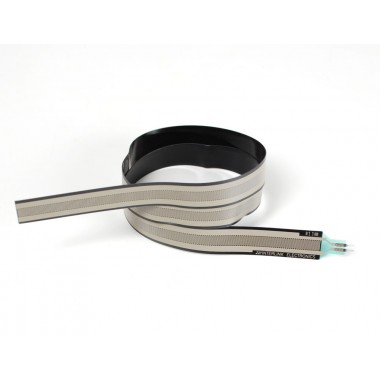Productos
Sensor de fuerza resistivo extra largo

Sensor de fuerza resistivo (FSR) extra largo para detectar presión, torsión y peso.
COD: D001071
Peso: 0.010 Kg
Disponibilidad: Sin Stock
ARS 74709.00
El producto no está disponible para la venta en este momento
Características
FSRs are sensors that allow you to detect physical pressure, squeezing and weight. They are simple to use and low cost. This sensor is a Interlink model 408 FSR with a massive 1/4-inch x 24-inch sensing region. You can press anywhere along the strip and the pressure will be recognized. Note that this sensor can't detect where on the strip you pressed.
FSRs are basically a resistor that changes its resistive value (in ohms Ω) depending on how much its pressed. These sensors are fairly low cost, and easy to use but they're rarely accurate. They also vary some from sensor to sensor perhaps 10%. So basically when you use FSRs you should only expect to get ranges of response. While FSRs can detect weight, they're a bad choice for detecting exactly how many pounds of weight are on them.
FSRs are made of plastic and the connection tab is crimped on delicate material. The best way to connect to these is to simply plug them into a breadboard or use a clamp-style connector like alligator clips, female header, or a terminal block. It is possible to solder onto the tabs but you must be very fast because if your iron is not good quality or you dally even a few seconds, you will melt the plastic and ruin the FSR! Don't attempt to solder directly to your FSR unless you are absolutely sure you have the skills to do so.
For a full tutorial with wiring diagrams, code examples and project ideas, please read the FSR tutorial
Dimensions:
- Length: 24in/609.6mm
- Width: 15.33mm/0.6in
- Thickness: 0.57mm/0.023in
- Weight: 5.03g/0.177oz
Comentarios
Escribir ComentarioOpenHacks (28/03/2016 - 14:14)
Esteban, con este sensor podes medir torsión. Fijate también si te sirven los flex sensors publicados en esta sección (Sensores->Fuerza). Provocan un cambio en su resistencia al ser doblados, pero no especifican comportamiento ante torsión (giro helicoidal). Saludos!
Esteban (27/03/2016 - 00:48)
Consulta. Yo necesito medir torsión y no presión. O sea necesito saber si la tira está recta o si la doblan. Me sirve esto o hay otro componente para lo que yo necesito? Gracias
OpenHacks (10/02/2015 - 15:54)
Si, se pueden conectar tanto en serie como en paralelo. Usando varios elementos mecánicamente en serie y eléctricamente en paralelo, se puede conseguir aumentar la carga emitida. Si los conectas en paralelo las fuerzas se repartirán entre los sensores de fuerza y deberás sumar todas para obtener el esfuerzo total.
Maximiliano (10/02/2015 - 10:31)
Se pueden poner varios en paralelo? Gracias




